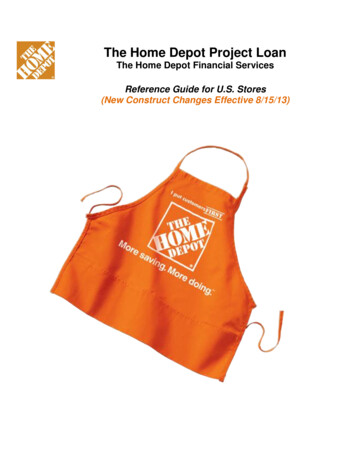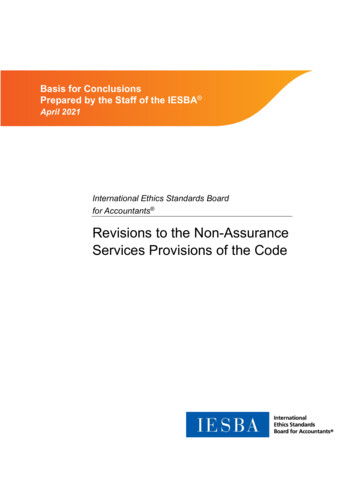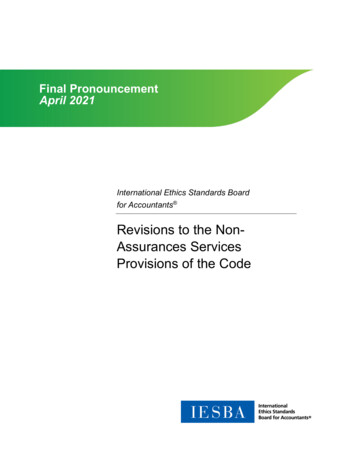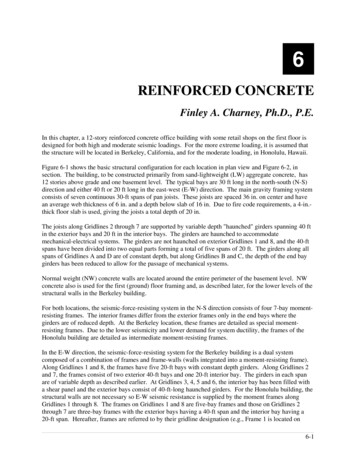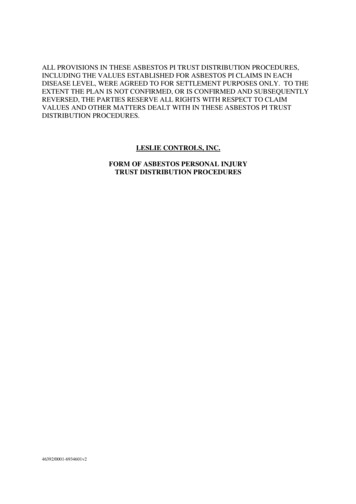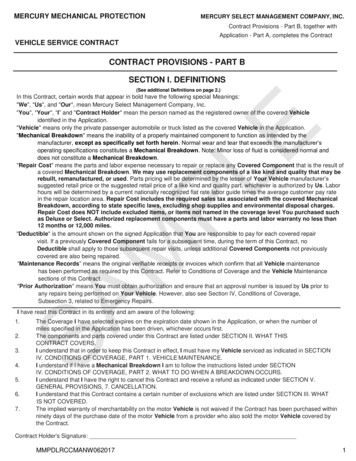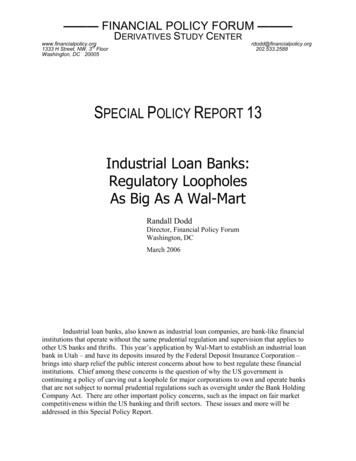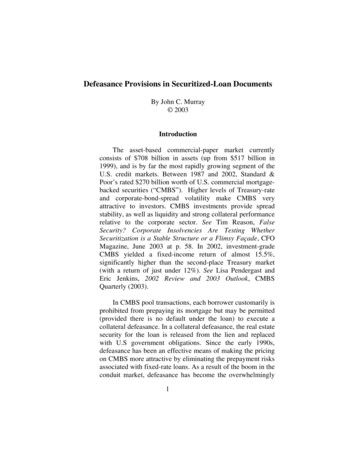
Transcription
Defeasance Provisions in Securitized-Loan DocumentsBy John C. Murray 2003IntroductionThe asset-based commercial-paper market currentlyconsists of 708 billion in assets (up from 517 billion in1999), and is by far the most rapidly growing segment of theU.S. credit markets. Between 1987 and 2002, Standard &Poor’s rated 270 billion worth of U.S. commercial mortgagebacked securities (“CMBS”). Higher levels of Treasury-rateand corporate-bond-spread volatility make CMBS veryattractive to investors. CMBS investments provide spreadstability, as well as liquidity and strong collateral performancerelative to the corporate sector. See Tim Reason, FalseSecurity? Corporate Insolvencies Are Testing WhetherSecuritization is a Stable Structure or a Flimsy Façade, CFOMagazine, June 2003 at p. 58. In 2002, investment-gradeCMBS yielded a fixed-income return of almost 15.5%,significantly higher than the second-place Treasury market(with a return of just under 12%). See Lisa Pendergast andEric Jenkins, 2002 Review and 2003 Outlook, CMBSQuarterly (2003).In CMBS pool transactions, each borrower customarily isprohibited from prepaying its mortgage but may be permitted(provided there is no default under the loan) to execute acollateral defeasance. In a collateral defeasance, the real estatesecurity for the loan is released from the lien and replacedwith U.S government obligations. Since the early 1990s,defeasance has been an effective means of making the pricingon CMBS more attractive by eliminating the prepayment risksassociated with fixed-rate loans. As a result of the boom in theconduit market, defeasance has become the overwhelmingly1
preferred alternative to yield-maintenance prepaymentpremiums in securitized mortgage financing. As one ratingagency has stated, “Today, loan defeasance has becomewidely accepted and is a structural characteristic in themajority of loans originated for purposes of securitization.”See Mary MacNeil, Erin Stafford, and Lee Green, Defeasanceby Design Update, Commercial Mortgage Special Report(Fitch Ratings, Feb. 14, 2001), at p. 1.Benefits of DefeasanceLenders and investors in securitized loan transactionsprefer defeasance to yield-maintenance prepayment provisionsbecause the certificate holders receive “call protection,”making pricing of the CMBS more attractive (by providing“tighter” spreads and cheaper financing) and providingsubstitute collateral that is safer and easier to realize on thanreal estate collateral (which may involve fluctuations in valueand expensive and time-consuming foreclosure proceedings),thereby virtually eliminating the default risk for the loan beingdefeased (although a yield-maintenance prepayment premiummay still apply if a loan default occurs). Defeasance alsoenhances yield predictability by reducing the risk ofreinvesting prepayment proceeds in an uncertain interest-rateenvironment, and reduces costs and the use of intermediaries.Unlike yield-maintenance prepayment provisions, defeasanceprovides for continuing payments over the remaining term ofthe loan. A defeased loan secured by U.S. governmentobligations (which are considered less risky collateral thancommercial real estate) is viewed as a positive event by therating agencies and may result in a ratings upgrade if a sizableportion of the CMBS pool is defeased.Typically, the costs to the borrower of defeasance areequal to or less than the costs of a yield-maintenanceprepayment of the loan. The master servicer calculates the2
cost of a yield-maintenance prepayment by the borrower inaccordance with the yield-maintenance formula in themortgage loan documents. On the other hand, defeasance is a“process” and the cost is calculated by combining transactioncosts and the securities cost along a yield curve. The borrowercustomarily will seek to defease its loan in connection with asale or refinance of the real property collateral, to takeadvantage of lower interest rates or higher yields (or torefinance for more money and for a longer term). Defeasancecosts to the borrower generally decrease the closer the loan isto its maturity date, because the property may haveexperienced significant appreciation and the loan balance hasdecreased (thus resulting in a lower cost of the defeasancedeposit). The overall cost to the borrower will be less withdefeasance than a yield-maintenance prepayment obligation ifthe defeasance occurs at a time when interest rates have risenin relation to the stated loan rate, i.e., the borrower will beable to purchase treasury instruments (or certain otherpermitted “government securities”) with a face value less thanthe outstanding loan balance. The borrower can effectively“hedge” its risk and will not pay any minimum prepaymentpremium regardless of the interest-rate environment (usuallyone percent in a yield-maintenance scenario). The borrower ina securitized loan transaction often will seek to gain flexibilityby requesting the ability to release collateral from themortgage, so that it can sell or refinance the real propertycollateral at any time. Therefore, a provision may be insertedin the mortgage granting the borrower a limited right tosubstitute collateral subject to rating agency approval andother requirements (generally based on new underwritingcriteria, with all costs of compliance to be paid for by theborrower).3
Nature and Scope of DefeasanceAccording to the Glossary of Terms: CommercialMortgage-Backed Securities (CMBS), published by theCommercial Mortgage Securitization Association (cmbs.org),2003, “Defeasance” is defined as:The act of making an investment whole. The supplementingof existing investment terms available (typically through acash payment) to make the currently available market yieldequivalent to that of a pre-existing investment that is beingterminated. Most commonly used in bond finance.Synonymous with yield maintenance. A commonprepayment option.Defeasance transactions in bond transactions generallyinvolve changes in the form of security with respect to debtinstruments. The issuer of the debt instruments (usually in theform of bonds) typically deposits into escrow, or a grantortrust account, a pool of U.S. Treasury obligations having anincome stream (principal and interest) sufficient to meet thepayment obligations on all or a portion of the bonds, i.e., aportfolio is selected that will provide a revenue stream ofinterest and/or principal payments sufficient to pay, when due,each scheduled principal and interest payment on the defeasedloan through the maturity date or such specified payment date.The loan principal due at maturity cannot vary and thegovernment securities selected are not subject to prepayment,call, or early redemption. Neither legal nor beneficialownership of the government securities is transferred to thebondholders. The transaction is treated for accountingpurposes as an extinguishment of the debt in which, forreporting purposes, the issuer is entitled to remove both thedebt and the Treasury obligations from its balance sheet.Actual or “true” defeasance occurs when all liens on assets, aswell as all covenants (other than covenants to repay the loan)and security interests created pursuant to the bond indenture4
or other evidence of indebtedness, are released (or“defeased”); however, the debt instrument itself is not retiredor satisfied.In connection with securitized real-estate-financingtransactions, one commentator has described defeasance asfollows:Defeasance is a device originallydeveloped in the corporate bondmarket, which has been adapted inrecent years for the mortgagesecurities market. In this arrangement,the loan documents permit noprepayment at all throughout the term.However, defeasance provides theborrower with liquidity and flexibility,similar to that which would exist withprepayment, even though the loanitself remains outstanding. Defeasanceentails the delivery by the borrower ofsubstitute collateral for the bonds, suchthat no prepayment occurs from thebond holders’ perspective. Thissubstitute collateral replaces themortgage, and accordingly the realproperty is released from the lien ofthe mortgage. Such collateral usuallyconsists of U.S. Treasury bills,purchased by the borrower, not subjectto prepayment, call or earlyredemption, with a maturity closest tothe loan maturity date in an amountwhich will generate sufficient principaland interest to pay debt service on theloan. If the loan bears interest at a ratehigher than then-current Treasury bills5
(which would be common in a normalinterest-rateenvironment),theborrower must purchase Treasury billsin a higher principal amount than theloan principal in order to meet the loandebt service. Defeasance in thiscontext thereby provides some surpluscollateral for bond holders. From theborrower’s perspective defeasancefunctions much like prepaymentsubjecttoyieldmaintenance.Typically, the borrower either sells orrefinances the mortgaged property anduses the proceeds to purchase therequired amount of Treasury bills.DuetoREMICrequirements,defeasance cannot be used within twoyears of loan securitization; prior tothis time, the borrower is subject to alockout.Steven G. Horowitz, Key Elements of Securitized LoanDocumentation, Commercial Real Estate Financing, 225PLI/Real 773, 781-82 (2000).Another commentator has described mortgageloan defeasance as follows:Modeled after an arrangement used bycorporations to remove bonds from theirbooks, defeasance requires the borrower topurchase U.S. government obligations forthe mortgagee's benefit precisely matchingthe interest and principal payments on thescheduled mortgage. The mortgageeaccepts the Treasury obligations assubstitute security, and releases its lien on6
the security property . . . Compared toyield maintenance clauses, defeasanceonly marginally disadvantages mortgagorsprepaying when rates have fallen. Insteadof paying a yield maintenance fee plus thebalance due on the debt, they purchasegovernment securities in an equivalentsum. When rates are significantly abovetheir contract rates, borrowers who wouldhave been entitled to prepay withoutcharge under yield maintenance clauses,will be shopping for Treasuries, ifdefeasance-burdened. The defeasanceborrower's only consolation is that ifinterest rates have risen enough to offsetthe spread between the borrower's interestrate and current Treasury yields, theborrower will be able to defease withTreasuries presently worth less than theloan balance. All defeasance-burdenedborrowers are penalized by having tofinance the spread between Treasury andmortgage rates.George Lefcoe, Prepayment Disincentives inSecuritized Commercial Loans, 224 PLI/Real 239,246 (1999).Defeasance is a highly technical and complex process andinvolves numerous parties, including the following:borrower; borrower’s counsel; master servicer; masterservicer’s counsel; accountants; rating agencies; successorborrower; securities broker-dealer; escrow agent; purchaser;purchaser’s counsel; new lender (trustee); new lender’scounsel; securities intermediary; securities intermediary’scounsel, and special servicer. Companies such as Newman &Associates and Commercial Defeasance, LLC now offer, for7
a fee, to act as consultants and perform and manage the fullrange of services involved in defeasing a CMBS loan, and tointeract with all necessary parties to effect a valid defeasance.Each of these companies maintains a “defeasance calculator”on its website, which enables a party considering defeasanceto calculate the “defeasance cost” to defease the loan byinputting the amount and certain financial terms of the loan.The online calculator provides security costs as well astransaction costs. Also, if the loan is still in the lockoutperiod, the borrower can make future projections on interestrates and perform a “sensitivity analysis.” There are also anumber of companies that will offer to serve solely as a“Broker Dealer” and purchase the securities required todefease a CMBS loan.It may be possible for the borrower in a defeasancetransaction to use the proceeds from the sale or refinance ofthe mortgage loan to purchase the required defeasancesecurities. However, in a securitized loan, REMIC rulesprohibit the payment of cash to the lender to purchase therequired U.S. government obligations. Trades to acquiresecurities require at least two days to settle before thetransferee is considered the owner of the securities. Theborrower may be able to obtain a bridge loan in the amountof the required defeasance collateral, with the purchasedsecurities serving as collateral for the loan, but the lendermay require additional cash or other collateral to covermarket-fluctuation risks. One commentator has suggestedthat the borrower may be able to structure the followingescrow arrangement with a title insurance company thatwould be satisfactory to the lender and the rating agencies,and that would comply with REMIC rules relating todefeasance:Where defeasance is being pursued inconnection with a sale or refinance of themortgaged property, the borrower may be8
able to work an escrow arrangement withthe title company conducting the closing.The arrangement would work as follow: (a)the lender delivers the release documents forthe mortgage collateral to the title companyin escrow and agrees to release thesedocuments once all of the enumeratedescrow conditions are satisfied; (b) the titlecompany insures over the lender’s mortgagelien in favor of the buyer or new lender onthe basis of such commitment, therebyallowing the sale or refinance of theproperty to close; and (c) at closing, theportion of the sales proceeds sufficient topurchase the defeasance securities is wiredto the investment adviser to purchase thesecurities.Once the securities are purchased with thesefunds and transferred to the securitiesintermediary (and all other conditions aresatisfied), the title company receives itsauthorization to record the mortgagedcollateral releases. The success of gettingthe title company’s cooperation with such anarrangement is more likely when the titlecompany is knowledgeable about defeasanceand the only remaining defeasanceconditions to be satisfied are payment anddelivery of the securities.Robin L. Litwa, Defeasance – A Practical Overview,Mortgage Banking (July 2000), at p.3.Attached hereto as Exhibit “A” a sample form of aprepayment/defeasance provision in a mortgage-loancommitment (or generic term sheet) for a securitized9
transaction. See Steven G. Horowitz, Co-LendingArrangements (Generic Term Sheet for Portfolio Financing),Tab 9 at 5 (April 4-5, 1997) (American College of RealEstate Lawyers Midyear Meeting on Finance Topics).Attached hereto, as Exhibits “B,” “C,” and “D” are sampleforms of specialized mortgage prepayment/defeasanceprovisions for use in securitized financing transactions.(Although Fannie Mae offers a defeasance option formultifamily CMBS, defeasance currently is only available forfixed-rate loans of 10.5 years or less including MultifamilyFannie Mae MBS, REMIC, and Cash executions. See ae/com/mbs/multfamily/defeasance(visitedAugust 25, 2003)).Enforceability of Defeasance ClausesDefeasance clauses are becoming the "norm" insecuritized mortgage transactions, including CMBS andREMIC financings, and surely there will be case law dealingwith mortgage defeasance in the not-too-distant future. Asnoted by Professor Lefcoe, "they [defeasance clauses] arejust as vulnerable [as yield-maintenance clauses] sincedefeasance calls for prepaying borrowers to substituteTreasury obligations for mortgages, instead of providing asubstitute property of equivalent risk. Defeasance is alsoobjectionable since it applies even to borrowers prepayingbelow market notes."George Lefcoe, PrepaymentDisincentives in Securitized Commercial Loans, supra,PLI/Real at 254. See also John C. Murray, Enforceability ofPrepayment-Premium Provisions in Mortgage LoanDocuments, John C. “Jack” Murray Reference Library rstam.com/faf/html/cust/jm-articles.html(visited August 25, 2003).10
There are only a few reported cases (either bankruptcy ornon-bankruptcy) that have discussed the enforceability ofdefeasance clauses in commercial loan documents. InBaybank Middlesex v. 1200 Beacon Properties, Inc., 760F.Supp. 957, 967-68 (1991), which arose out of the financingof the renovation and addition to a hotel located in Brookline,Massachusetts, the bond indenture provided for defeasance(termination) of the lien securing the bonds after the trusteehad received all the outstanding principal, premium andinterest due from the borrower. The defeasance provision inthe indenture also provided that the bonds would be deemedpaid in full at such time as there was irrevocably delivered tothe trustee sufficient cash or U.S. obligations with maturitiesand interest rates sufficient to produce cash “(1) to prepay theBonds in whole at the earliest date permitted or required by[other sections of the agreement]; or (2) to pay any principaland premium, if any, and interest on the Bonds which may bedue, or overdue and to make all remaining payments orprincipal and premium, if any, and interest on the Bonds asthey come due.” Id. at 968. The court found that thisprovision, together with other provisions in the loandocuments, demonstrated the parties’ intent that, upondefault, the lender’s recovery would be limited to thosedamages specifically provided under the terms of theagreements. The court ruled that acceleration of the amountdue under the mortgage and trust indenture as the result of adefault when the bonds used to finance the real estatedevelopment became taxable, precluded the lender andtrustee from seeking unearned interest on the bonds asadditional damages. This was so, the court found, because thetrust indenture clearly indicated the parties’ intention thatupon the occurrence of such a default, the trustee wasrequired to declare the outstanding principal, accrued interestand premiums immediately due and payable. See alsoFidelity Nat’l Title Ins. Co. v. Intercounty Nat’l Title Ins.Co., 2001 U.S. Dist. LEXIS 478 (Jan. 22, 2001), at *7-8(describing the hazards of title-insurance agents participating11
in a mortgage defeasance program where buyers’ funds inconnection with title conveyances and refinancings wereinvested in “high-yield junk bonds”).See generally Neil D. Baron, Mortgage and Asset-BackedSecurities in Conservatorship or Receivership, CounselingCreditors of Banks and Thrifts: Dealing with the FDIC andRTC, 561 PLI/Comm 313, 323 (1991); Roger D. Turner,Selected Issues Relating to Domestic Private Placements andPublic Offerings in Europe of Mortgage-Backed Obligations,Securitization of Commercial Real Estate, 283 PLI/Real 247,283 (1986); American Bar Association Section of TaxationTask Force Report on Prop. Regs. § 1.001-3: Modificationsof Debt Instruments [Parts VI-VII], 48 Tax L. 177, 191(1994); James M. Johnson, Robert A. Pari, and LeonardRosenthal, The Impact of In-Substance Defeasance onBondholder and Shareholder Wealth, 44 J. Fin. 1049 (1989);George Lefcoe, Yield Maintenance and Defeasance: TwoDistinct Paths to Commercial Mortgage Payment, 28 RealEst. L. J. (Winter 2000).“In-Substance” DefeasanceAlthough defeasance of underlying loan obligations inasset-backed transactions is a relatively recent phenomenon,bond defeasance has been common for many years in publicfinance transactions. In a typical “in-substance” defeasance,a pool of Treasury instruments is dedicated by the issuer ofbonds as a segregated source of payment of the obligationsdue; but (unlike a true defeasance) the bondholders areusually not granted a pledge or any lien or other securityinterest in the Treasuries, the borrower remains fully liableunder the loan and indenture covenants, and no other existingsecurity interests are released.12
In order to offer call protection for investors, somemortgage-backed bond indentures p
cost of a yield-maintenance prepayment by the borrower in accordance with the yield-maintenance formula in the mortgage loan documents. On the other hand, defeasance is a “process” and the cost is calculated by combining transaction costs and the securitie

